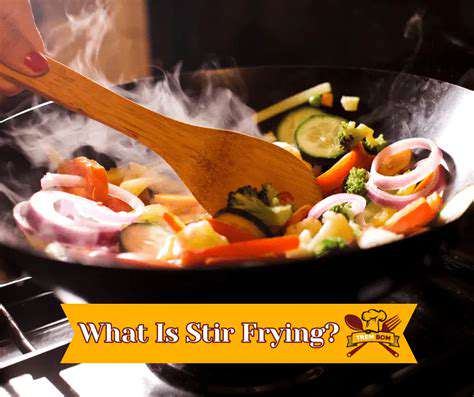Food Culture in Australia: BBQ and Seafood
Beyond the BBQ: Exploring Other Australian Cuisine Influences
Indigenous Australian Culinary Traditions
Indigenous Australian cuisine, deeply rooted in the land and its resources, offers a fascinating glimpse into a rich culinary history. For millennia, Aboriginal and Torres Strait Islander peoples have developed sophisticated methods of foraging, hunting, and gathering, creating diverse and nutritious dishes tailored to the specific environments they inhabited. This knowledge, passed down through generations, emphasizes sustainability and respect for the land. The use of bush tucker, including native fruits, vegetables, and meats, is central to these traditions, demonstrating an intimate understanding of the natural world and its bounty. This knowledge is not just about food; it's a vital part of cultural identity and connection to ancestral lands.
Traditional cooking methods, such as smoking and roasting over open fires, played a crucial role in preserving and enhancing the flavour of ingredients. These techniques, often passed down through oral traditions, are essential to understanding the cultural significance of food in Indigenous Australian societies. Modern chefs are increasingly recognizing and incorporating these ancient practices into their work, helping to preserve and celebrate this important part of Australia's culinary heritage. The ongoing efforts to revitalize and share these traditions are vital for maintaining cultural continuity and acknowledging the deep connection between Indigenous Australians and their food.
Mediterranean and European Influences
Australia's history of immigration has significantly shaped its cuisine, introducing a wide range of flavours and techniques from across the globe. The arrival of European settlers brought with it a wealth of Mediterranean and European culinary traditions, which blended with existing practices to create a unique Australian flavour profile. These influences are particularly evident in the use of fresh produce, herbs, and spices, contributing to the popularity of dishes like pasta, pizza, and various Mediterranean salads. This exchange of culinary ideas has contributed to the diverse and vibrant food scene that exists in Australia today.
The introduction of European baking techniques and ingredients, such as bread, pastries, and cheeses, further enriched the Australian culinary landscape. These elements became integral components of both everyday meals and special occasions. The enduring popularity of traditional European dishes, adapted to suit Australian tastes and ingredients, showcases the impact of these early culinary influences on the national palate.
Asian Culinary Inspirations
The significant influx of Asian immigrants has also left an indelible mark on Australian cuisine, infusing it with vibrant flavours and innovative techniques. From the diverse street food stalls found in major cities to the renowned restaurants showcasing sophisticated Asian cooking, the influence of Asian cultures is evident throughout the country. The fusion of Asian flavors with traditional Australian ingredients has led to the creation of unique and delicious dishes that reflect the multiculturalism of Australian society.
The emphasis on fresh ingredients, innovative cooking techniques, and the use of various spices and sauces in Asian cuisines has broadened the Australian palate. This has led to the development of new culinary trends and a greater appreciation for global flavours. The popularity of Vietnamese pho, Thai curries, Chinese dim sum, and Japanese sushi exemplifies the growing importance of Asian culinary contributions to Australia's food culture.
Modern Australian Cuisine: A Blend of Global Influences
Modern Australian cuisine is a dynamic and evolving entity, drawing on a tapestry of global influences. This fusion of flavours and techniques has created a distinctly Australian culinary identity, characterized by a focus on fresh, seasonal ingredients and innovative preparation methods. The rise of celebrity chefs and culinary programs has further propelled the evolution of this unique style of cooking, showcasing the creativity and passion of Australian food artisans.
Modern Australian chefs are not only reinterpreting traditional dishes but also creating entirely new culinary experiences. The emphasis on sustainability and ethical sourcing of ingredients is becoming increasingly prevalent, reflecting a growing awareness of the environmental and social impact of food production. This forward-thinking approach is helping to shape a future where Australian cuisine is not just delicious but also responsible and sustainable.
The Future of Australian Food Culture: Innovation and Tradition
Global Influences Shaping Australian Palates
Australian food culture is experiencing a fascinating evolution, increasingly influenced by global culinary trends. From vibrant street food markets showcasing diverse cuisines to innovative restaurants embracing international techniques, Australians are actively seeking out and integrating flavours from around the world. This fusion of traditions is creating a dynamic and exciting landscape, with new ingredients and preparation methods enriching the Australian dining experience and pushing culinary boundaries.
The rise of international migration has played a significant role in this transformation. Immigrants bring with them not only their own culinary heritage but also a wealth of knowledge and experience that enriches the broader Australian food scene. This cultural exchange leads to the development of unique hybrid dishes, showcasing the best of both worlds and contributing to the vibrant tapestry of Australian food culture.
Sustainable Practices and Local Produce
Growing awareness of environmental concerns is driving a shift towards more sustainable food practices in Australia. Consumers are increasingly seeking out locally sourced, seasonal produce, reducing their environmental footprint while supporting local farmers and businesses. This emphasis on sustainability is evident in the rise of farmers' markets, community gardens, and initiatives promoting the consumption of regionally grown food.
The Australian landscape, with its diverse climates and fertile regions, provides a wealth of fresh, high-quality produce. This emphasis on local ingredients is not only beneficial for the environment but also enhances the flavour and nutritional value of Australian dishes. Farmers are embracing sustainable agricultural practices, while consumers are actively choosing to support these initiatives, creating a positive feedback loop that benefits both the environment and the food industry.
The Rise of Indigenous Australian Cuisine
Indigenous Australian food culture, with its deep-rooted connection to the land and its rich history, is experiencing a resurgence. The ancient knowledge of traditional ingredients and preparation methods is being rediscovered and revitalized, with chefs and food enthusiasts working to preserve and promote this unique culinary heritage. This renewed appreciation highlights the significance of Indigenous perspectives and knowledge in shaping the Australian food narrative.
Innovation in Restaurant Scene
Australian chefs are pushing creative boundaries, incorporating innovative techniques and global influences into their dishes. Modern Australian cuisine is characterized by a focus on fresh, high-quality ingredients, often showcasing the best of local produce, while still embracing international culinary trends. This approach encourages creativity and experimentation, resulting in a diverse range of dining experiences for Australians and visitors alike.
The Future of Food Retail and Hospitality
The Australian food retail and hospitality industries are responding to evolving consumer preferences, embracing technology and innovation to improve the customer experience. From online food delivery services to subscription boxes highlighting local produce, Australians are increasingly embracing modern ways to access and enjoy their food. These changes reflect a desire for convenience and accessibility, combined with a growing interest in supporting local producers and sustainable practices. The future of Australian food is intrinsically linked to the dynamic interplay between traditional values, modern innovation, and a growing appreciation for global cuisines.
Read more about Food Culture in Australia: BBQ and Seafood
Hot Recommendations
- Traditional Foods for Day of the Dead
- Food Etiquette in Italy: Pasta Rules!
- Best Family Friendly Restaurants with Play Areas in [City]
- Review: The Best [Specific Dessert] Place in [City]
- Top Ice Cream Parlors in [City]
- Traditional Foods for Halloween
- The History of the Potato in Ireland
- Best Vegan Pizza Joints in [City] [2025]
- Best Bakeries for Sourdough Bread in [City]
- Food Culture in Argentina: Asado and Wine

![Review: The Best [Cuisine] Outside [Country of Origin]](/static/images/28/2025-05/BeyondtheMainstream3ADiscoveringHiddenGems.jpg)








![Top Speakeasy Bars with Great Food in [City]](/static/images/28/2025-07/Indulginginthe5BCity5DSpeakeasyExperience.jpg)
